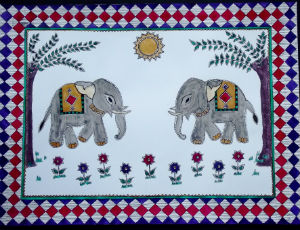Harold Washington Library Center hosts an Asian American and Pacific Islander Heritage Month art exhibit featuring the work of artist Sumathi Natarajan.
Paintings from Sumathi Natarajan’s collection will be on display from May 1 through July 1 on the 3rd floor of the Harold Washington Library Center.
Artist Statement
“My work revolves around reviving the ancient art forms of rural India. I aim to bring about international awareness of these unique Indian art forms through my body of work.
"I have been particularly fascinated by the Warli art form, which originated from the villages of the state of Maharashtra, India. The elements and the media used in this art form are extremely simple. Yet the impressions created speak volumes and provide a rich insight into the day-to-day life of the Warli tribes in rural Maharashtra; tribal dances, social and cultural events, people, flora and fauna. Simple geometric shapes—circles and triangles—are used throughout the paintings. The colors used in Warli art are predominantly red or brown for the background, with white paint prepared by using rice paste and water used for the icons/characters. Traditionally, the Warli artisans used the walls of their huts as their medium. I personally like to use paper as the medium and black, white or metallic-colored acrylics for the artwork.
"A stark contrast to the Warli art form is the Madhubani. This style of painting is a part of a rich cultural heritage that originated from the Mithila region of the eastern Indian state of Bihar, India. Traditionally, paintings were created on the walls of huts using fingers and/or twigs. Bright and vivid colors made of plant-based dyes were used. A majority of the subjects in these paintings were caricatured mythological figures and the motifs included flora and fauna. In recent times artists have used fabric or paper to depict this art form. I like to use paper and Bombay/calligraphy ink, experimenting with different nibs.”

